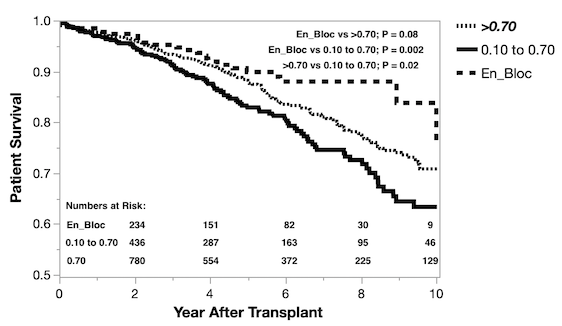Donor-Recipient BSA Matching is Prognostically Significant in Solitary and En-bloc Kidney Transplantation from Pediatric Circulatory Death Donors
Department of Surgery, University of Washington, Seattle, WA
Meeting: 2021 American Transplant Congress
Abstract number: 398
Keywords: Allocation, Cadaveric organs, Kidney transplantation, Survival
Topic: Clinical Science » Kidney » Kidney Deceased Donor Allocation
Session Information
Session Name: Kidney Deceased Donor Allocation 1
Session Type: Poster Video Chat
Date: Saturday, June 5, 2021
Session Time: 7:30pm-8:30pm
 Presentation Time: 7:30pm-7:40pm
Presentation Time: 7:30pm-7:40pm
Location: Virtual
*Purpose: The purpose of this study was to evaluate the pernicious effects of inadequate functional nephron mass in size disparate donation after cardiac death (DCD) kidney transplantation between pediatric donors and adult recipients by characterizing the impact of donor-recipient (D-R) body surface area (BSA) mismatch on long-term graft and patient survival.
*Methods: Utilizing the Organ Procurement and Transplantation Network (UNOS) database, a retrospective analysis was performed for all adult (18 years or older) recipients of pediatric (17 years or younger) DCD kidneys in the US from 1/1/2004-3/10/2020. The primary outcomes included death-censored graft survival, all-cause graft survival, and patient survival. The cohorts were defined by D-R BSA ratios of 0.10-0.70, >0.70-0.91, and >0.91.
*Results: Solitary DCD pediatric allografts transplanted between D-R pairs with a BSA ratio of 0.10-0.70 carried an increased risk of all-cause graft failure (RR 1.36; CI 1.10-1.69) and patient death (RR 1.32; CI 1.01-1.73) when compared to pairings with a ratio of >0.91. There was no difference in death-censored graft survival between these cohorts. Additionally, there was no difference in graft or patient survival between the >0.70-0.91 and >0.91 cohorts. Kaplan-Meier survival analysis revealed improved 10-year patient survival in recipients of en-bloc allografts (P = 0.02) compared to recipients of single kidneys with D-R BSA ratios of 0.10-0.70. A similar survival advantage was demonstrated in recipients of solitary allografts with D-R BSA ratios >0.70 (P = 0.02).
*Conclusions: Donor-recipient size disparity is associated with inferior patient and all-cause graft survivals, which can be overcome by appropriate BSA matching or en-bloc transplantation. The deleterious effects of mismatched D-R BSA ratios are likely attributed to the well described systemic sequelae of insufficient renal functional capacity. Therefore, D-R BSA matching is prognostically significant when considering allocation strategies for DCD kidneys from pediatric donors. Specifically, a D-R BSA ratio of >0.70 represents the safe lower limit for solitary kidney transplantation, while a ratio of 0.10-0.70 serves as criteria for en-bloc allocation.
To cite this abstract in AMA style:
Little CJ, Dick AA, Perkins JD, Reyes JD. Donor-Recipient BSA Matching is Prognostically Significant in Solitary and En-bloc Kidney Transplantation from Pediatric Circulatory Death Donors [abstract]. Am J Transplant. 2021; 21 (suppl 3). https://atcmeetingabstracts.com/abstract/donor-recipient-bsa-matching-is-prognostically-significant-in-solitary-and-en-bloc-kidney-transplantation-from-pediatric-circulatory-death-donors/. Accessed December 29, 2025.« Back to 2021 American Transplant Congress

